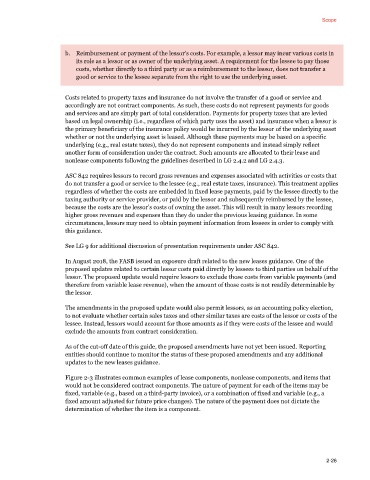Page 47 - pwc-lease-accounting-guide_Neat
P. 47
Scope
b. Reimbursement or payment of the lessor’s costs. For example, a lessor may incur various costs in
its role as a lessor or as owner of the underlying asset. A requirement for the lessee to pay those
costs, whether directly to a third party or as a reimbursement to the lessor, does not transfer a
good or service to the lessee separate from the right to use the underlying asset.
Costs related to property taxes and insurance do not involve the transfer of a good or service and
accordingly are not contract components. As such, these costs do not represent payments for goods
and services and are simply part of total consideration. Payments for property taxes that are levied
based on legal ownership (i.e., regardless of which party uses the asset) and insurance when a lessor is
the primary beneficiary of the insurance policy would be incurred by the lessor of the underlying asset
whether or not the underlying asset is leased. Although these payments may be based on a specific
underlying (e.g., real estate taxes), they do not represent components and instead simply reflect
another form of consideration under the contract. Such amounts are allocated to their lease and
nonlease components following the guidelines described in LG 2.4.2 and LG 2.4.3.
ASC 842 requires lessors to record gross revenues and expenses associated with activities or costs that
do not transfer a good or service to the lessee (e.g., real estate taxes, insurance). This treatment applies
regardless of whether the costs are embedded in fixed lease payments, paid by the lessee directly to the
taxing authority or service provider, or paid by the lessor and subsequently reimbursed by the lessee,
because the costs are the lessor’s costs of owning the asset. This will result in many lessors recording
higher gross revenues and expenses than they do under the previous leasing guidance. In some
circumstances, lessors may need to obtain payment information from lessees in order to comply with
this guidance.
See LG 9 for additional discussion of presentation requirements under ASC 842.
In August 2018, the FASB issued an exposure draft related to the new leases guidance. One of the
proposed updates related to certain lessor costs paid directly by lessees to third parties on behalf of the
lessor. The proposed update would require lessors to exclude those costs from variable payments (and
therefore from variable lease revenue), when the amount of those costs is not readily determinable by
the lessor.
The amendments in the proposed update would also permit lessors, as an accounting policy election,
to not evaluate whether certain sales taxes and other similar taxes are costs of the lessor or costs of the
lessee. Instead, lessors would account for those amounts as if they were costs of the lessee and would
exclude the amounts from contract consideration.
As of the cut-off date of this guide, the proposed amendments have not yet been issued. Reporting
entities should continue to monitor the status of these proposed amendments and any additional
updates to the new leases guidance.
Figure 2-3 illustrates common examples of lease components, nonlease components, and items that
would not be considered contract components. The nature of payment for each of the items may be
fixed, variable (e.g., based on a third-party invoice), or a combination of fixed and variable (e.g., a
fixed amount adjusted for future price changes). The nature of the payment does not dictate the
determination of whether the item is a component.
2-26

